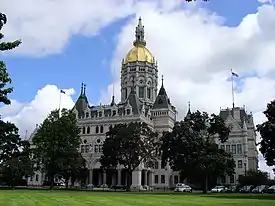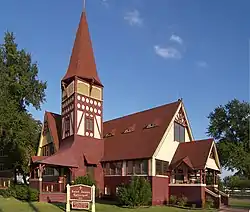Richard M. Upjohn
Richard Michell Upjohn, FAIA, (March 7, 1828 – March 3, 1903) was an American architect, co-founder and president of the American Institute of Architects.
Richard Michell Upjohn | |
|---|---|
 | |
| Born | March 7, 1828 |
| Died | March 3, 1903 (aged 74) |
| Occupation | Architect |
| Spouse |
Emma Degen Tyng (m. 1856) |
| Buildings | Connecticut State Capitol in Hartford |
_crop.jpg.webp)

Early life and career
Upjohn was born on March 7, 1828, in Shaftesbury, Dorsetshire, England and his family emigrated to the United States in 1829. He was the son of the famous architect Richard Upjohn (1802–1878) and Elizabeth (née Parry) Upjohn (1803–1882).[1]
In 1853, at eighteen years old, he joined his father's New York architectural firm to study architecture and later became his father's partner. The earliest building that architectural scholars credit to him alone is Madison Square Presbyterian Church in New York City, built from 1853 to 1854. He became best known, much like his father, for his High Gothic Revival style of architecture.[2] He, again like his father, was a founding member and president of the American Institute of Architects.[3]
A number of noteworthy architects trained in his office, including Clarence Fagan True.[4] A number of buildings that he designed are now listed on the National Register of Historic Places (NRHP). Four are listed as National Historic Landmarks.[5]
Personal life
On October 1, 1856, Upjohn was married to Emma Degen Tyng (1836–1906).[6] Together, they were the parents of three daughters and five sons, including Hobart Upjohn, who practiced as a civil engineer and architect.[3]
Upjohn died on March 3, 1903, at his home, 296 Clinton Street,[7] in Brooklyn, New York.[3] He was buried in Green-Wood Cemetery, for which he and his father had done design work many years before.[8]
Works with Richard Upjohn
- St. John Chrysostom Church (1851) in Delafield, Wisconsin, on the NRHP
- St. Peter's Episcopal Church (1859) in Albany, New York, a National Historic Landmark[9]
- Trinity-St. Paul's Episcopal Church (1862–63) in New Rochelle, New York, on the NRHP
- All Saint's Memorial Church (1864) in Navesink, New Jersey, a National Historic Landmark
- The third Saint Thomas Church (1865–70) in New York City, destroyed by fire in 1905
- Green-Wood Cemetery (1860s) in Brooklyn, New York, a National Historic Landmark
- Edwin A. Stevens Hall (1871) in Hoboken, New Jersey, on the NRHP
- St. Paul's Episcopal Church (1871–75) in Selma, Alabama, on the NRHP
Works as Richard M. Upjohn
Individual projects include:[10]
- Madison Square Presbyterian Church (1853–54), at Madison Avenue and 24th Street, New York City, demolished for Stanford White's Madison Square Presbyterian Church (1906)
- St. James Episcopal Church (1855) in La Grange, Texas, on the NRHP
- St. Luke's Church (1857) in Clermont, New York, on the NRHP
- Christ Church Episcopal (1866) in Riverdale, New York, on the NRHP
- St. Alban's Episcopal Church (1865) in Staten Island, New York, on the NRHP
- Church of the Covenant (1865–67) in Boston, Massachusetts
- St. Paul's Church (1866) in Brooklyn, New York, on the NRHP
- St. John's Protestant Episcopal Church (1869) in Stamford, Connecticut, on the NRHP
- Trinity Church (1871) in Thomaston, Connecticut, on the NRHP
- First National Bank (1871) in Salt Lake City, Utah, on the NRHP[11]
- Connecticut State Capitol (1871-1878) in Hartford, Connecticut, a National Historic Landmark[12]
- Saint Andrew's Episcopal Church (1873) in Rochester, New York, on the NRHP
- Fay Club (1883) in Fitchburg, Massachusetts, on the NRHP
- Church of St. Joseph of Arimathea (1883) in Greenburgh, New York, on the NRHP
- St. Mark's Episcopal Church (1886) in Augusta, Maine, on the NRHP
- St. Margaret of Antioch Episcopal Church (1892) in Staatsburg, New York.[13]
- St. George's Protestant Episcopal Church (1887) in Brooklyn, New York, on the NRHP
- St. Peter's Episcopal Church (1891) in Peekskill, New York, on the NRHP
- Church of St. John in the Wilderness (1852) in Copake Falls, New York, on the NRHP
References
- Upjohn, Everard Miller (1939). Richard Upjohn, Architect and Churchman. Columbia University Press. p. 22. Retrieved 22 April 2019.
- Woods, Mary N. (1999). From Craft to Profession: The Practice of Architecture in Nineteenth-Century America. University of California Press. p. 217. ISBN 9780520214941. Retrieved 22 April 2019.
- "DEATH OF RICHARD M. UPJOHN.; A Prominent Architect and One of the Investigators of the State Capitol Building at Albany" (PDF). The New York Times. 4 March 1903. Retrieved 22 April 2019.
- Christopher Gray, "Streetscapes | Clarence True: Row House Wrangler, Chuck Wagon Consultant", New York Times, 5 May 2011 (Retrieved 10 May 2011)
- "National Register Information System". National Register of Historic Places. National Park Service. January 23, 2007.
- The Genealogy of the Cleveland and Cleaveland Families: An Attempt to Trace in Both the Male and Female Lines, the Posterity of Moses Cleveland ... [and] of Alexand Cleveland ... with Numerous Biographical Sketches; and Containing Ancestries of Many of the Husbands and Wives, Also a Bibliography Account of Edward Winn of Woburn, and of Other Winn Families. Case, Lookwood & Brainard. 1899. pp. 1764–1765. ISBN 9780598463906. Retrieved 22 April 2019.
- Morrone, Francis (2001). An Architectural Guidebook to Brooklyn. Gibbs Smith. p. 184. ISBN 9781423619116. Retrieved 22 April 2019.
- Doumato, Lamia (1984). Richard Upjohn, Richard Michell Upjohn, and the Gothic revival in America. Monticello, Illinois: Vance Bibliographies. pp. 1–9. ISBN 978-0-89028-128-4.
- Society, Geneva Historical (2003). Geneva. Arcadia Publishing. p. 119. ISBN 9781439611869. Retrieved 22 April 2019.
- Garraty, John Arthur; Carnes, Mark Christopher; Societies, American Council of Learned (1999). American National Biography: Tunnicliff-Welk. Oxford University Press. ISBN 9780195128017. Retrieved 22 April 2019.
- Roberts, Allen Dale (2012). Salt Lake City's Historic Architecture. Arcadia Publishing. p. 38. ISBN 9780738595160. Retrieved 22 April 2019.
- Pierce, Patricia Dawes (1979). Monument, the Connecticut State Capitol. Old State House Association. Retrieved 22 April 2019.
- "History". St. Margaret's Episcopal Church. Retrieved 25 June 2021.